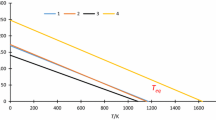Abstract
Some possible elementary reactions are not included in the classical mathematical models of thermal decomposition. For example, we can assume that in the thermal decompositions of simple carbonates a proportion of the O2− ions produced on the reaction interface can migrate into the interior of the reactant phase, since at this temperature there is some probability of CO2 exchange between an O2− and a neighbouring CO 2−3 ion. A similar diffusion-type process can be assumed in a wide class of decomposition reactions. The present state of computer science makes it possible to show by mathematical modelling how this migration influences the TG curves of the simplest contracting-sphere-type reactions. The resulting extended contracting-sphere model can provide the induction and the acceleration period of the TG curves.
Résumé
Quelques réactions élémentaires possibles ne sont pas prises en compte dans le modèle mathématique classique de la décomposition thermique. On peut, par ex., supposer que lors de la décomposition thermique des carbonates simples, une partie des ions O2− formés à l'interface de réaction puisse migrer à l'intérieur de la phase réagissante, puisqu'à cette température il existe une certaine probabilité d'échange entre un O2− et un ion CO 2−3 voisin. On peut supposer un processus similaire du type diffusionnel chez un grand nombre de réactions de décomposition. L'état actuel de la science des ordinateurs permet de montrer, à partir de modèles mathématiques, l'influence de cette migration sur les courbes TG des réactions les plus simples du type sphères de contraction. L'extension du modèle des sphères de contraction peut indiquer les périodes d'induction et d'accélération sur les courbes TG.
Zusammenfassung
Einige mögliche Elementarreaktionen sind in dem klassischen mathematischen Modell der thermischen Zersetzung nicht enthalten. Z. B. kann angenommen werden, daß bei der thermischen Zersetzung einfacher Carbonate ein Teil der an der Reaktionsgrenzschicht entstandenen O2−-Ionen in das Innere der reagierenden Phase wandern kann, da bei dieser Temperatur eine gewisse Wahrscheinlichkeit eines CO2-Austausches zwischen einem O2− und einem benachbarten CO 2−3 -Ion besteht. Ein ähnlicher Vorgang vom Diffussionstyp kann bei einer großen Gruppe von Zersetzungsreaktionen angenommen werden. Die gegenwärtige Lage der Komputerwissenschaft ermöglicht an Hand der mathematischen Modellierung den Einfluß dieser Wanderung auf die TG-Kurven der einfachsten Reaktionen vom Typ der Kontraktionssphären zu zeigen. Das erhaltene erweiterte Kontraktionssphären-Modell kann die Induktions- und Beschleunigungsabschnitte der TG-Kurven liefern.
Резюме
В классических матем атических моделях термического разлож ения не содер-жались некоторые возможные элементарные реакци и. Так, например, можно допус тить, что при термическом р азложении простых ка рбонатов часть O2− ионов, образу ющихся на реакционной поверхн ости раздела, может ми грировать внутрь реагирующей ф азы, поскольку при этой температуре имеется некоторая возможность обмена CO2 между O2− и соседним CO 2−3 ионом. Мож но допускать, что подо бный диффузионный процес с возмо-жен в широком классе реакц ий разложения. Соврем енный уровень вычислитель ной техники позволяет показать с помощью математичес кого моделирования каким образом такая миграция оказывает в лияние на кривые ТГ пр остейших типов реакций с сжима емой сферой. Такая модель результ ирующей расширенно-с жимаемой сферы может давать ин дукционный период и период ускор ения кривых ТГ.
Similar content being viewed by others
References
D. A. Young, Decomposition of Solids, Pergamon Press, Oxford etc. 1966.
A. Fevre andM. Murat, J. Thermal Anal., 7 (1975) 429.
A. B. Tayler, Moving Boundary Problems in Heat Flow and Diffusion, Ed. J. R. Ockendon and W. R. Hodgkins, Clarendon Press, Oxford, 1975, pp. 120–138.
L. W. Ehrlich, J. Assoc. Comput. Mach., 5 (1958) 1961.
Author information
Authors and Affiliations
Rights and permissions
About this article
Cite this article
Várhegyi, G., Székely, T. Mathematical modelling of thermal decomposition processes. Journal of Thermal Analysis 12, 179–185 (1977). https://doi.org/10.1007/BF01909474
Received:
Issue Date:
DOI: https://doi.org/10.1007/BF01909474



